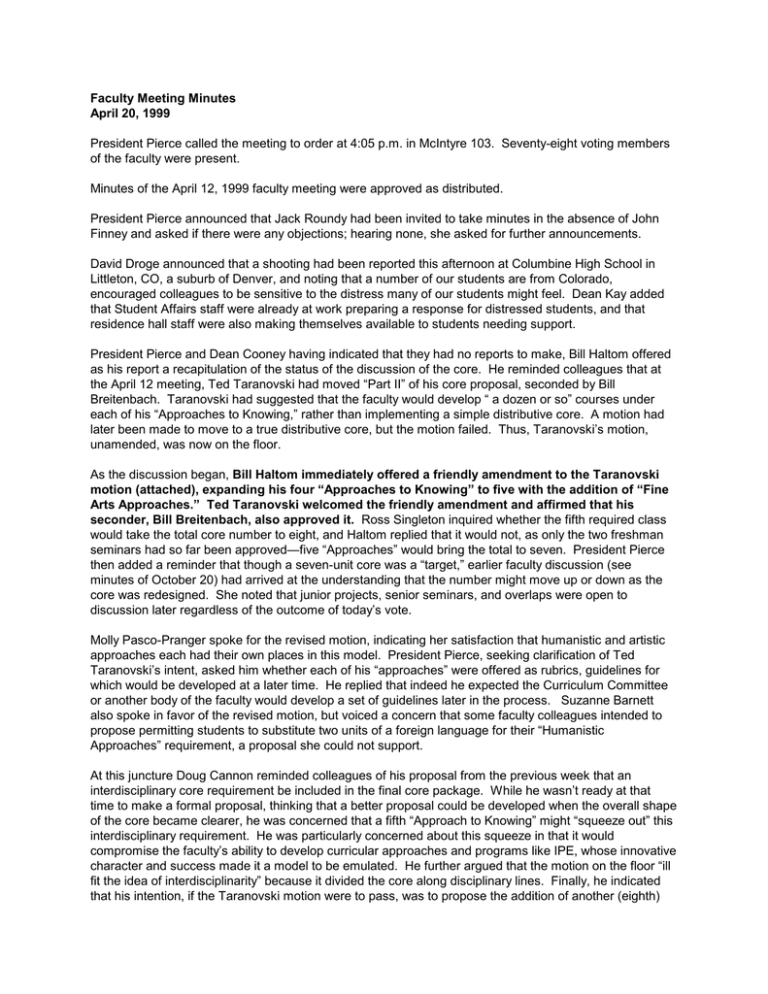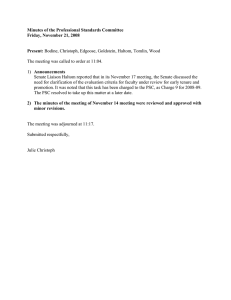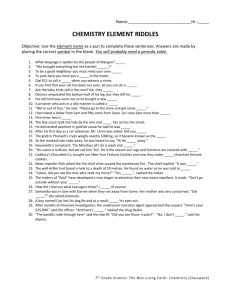President Pierce called the meeting to order at 4:05 p.m.... Faculty Meeting Minutes April 20, 1999
advertisement

Faculty Meeting Minutes April 20, 1999 President Pierce called the meeting to order at 4:05 p.m. in McIntyre 103. Seventy-eight voting members of the faculty were present. Minutes of the April 12, 1999 faculty meeting were approved as distributed. President Pierce announced that Jack Roundy had been invited to take minutes in the absence of John Finney and asked if there were any objections; hearing none, she asked for further announcements. David Droge announced that a shooting had been reported this afternoon at Columbine High School in Littleton, CO, a suburb of Denver, and noting that a number of our students are from Colorado, encouraged colleagues to be sensitive to the distress many of our students might feel. Dean Kay added that Student Affairs staff were already at work preparing a response for distressed students, and that residence hall staff were also making themselves available to students needing support. President Pierce and Dean Cooney having indicated that they had no reports to make, Bill Haltom offered as his report a recapitulation of the status of the discussion of the core. He reminded colleagues that at the April 12 meeting, Ted Taranovski had moved “Part II” of his core proposal, seconded by Bill Breitenbach. Taranovski had suggested that the faculty would develop “ a dozen or so” courses under each of his “Approaches to Knowing,” rather than implementing a simple distributive core. A motion had later been made to move to a true distributive core, but the motion failed. Thus, Taranovski’s motion, unamended, was now on the floor. As the discussion began, Bill Haltom immediately offered a friendly amendment to the Taranovski motion (attached), expanding his four “Approaches to Knowing” to five with the addition of “Fine Arts Approaches.” Ted Taranovski welcomed the friendly amendment and affirmed that his seconder, Bill Breitenbach, also approved it. Ross Singleton inquired whether the fifth required class would take the total core number to eight, and Haltom replied that it would not, as only the two freshman seminars had so far been approved—five “Approaches” would bring the total to seven. President Pierce then added a reminder that though a seven-unit core was a “target,” earlier faculty discussion (see minutes of October 20) had arrived at the understanding that the number might move up or down as the core was redesigned. She noted that junior projects, senior seminars, and overlaps were open to discussion later regardless of the outcome of today’s vote. Molly Pasco-Pranger spoke for the revised motion, indicating her satisfaction that humanistic and artistic approaches each had their own places in this model. President Pierce, seeking clarification of Ted Taranovski’s intent, asked him whether each of his “approaches” were offered as rubrics, guidelines for which would be developed at a later time. He replied that indeed he expected the Curriculum Committee or another body of the faculty would develop a set of guidelines later in the process. Suzanne Barnett also spoke in favor of the revised motion, but voiced a concern that some faculty colleagues intended to propose permitting students to substitute two units of a foreign language for their “Humanistic Approaches” requirement, a proposal she could not support. At this juncture Doug Cannon reminded colleagues of his proposal from the previous week that an interdisciplinary core requirement be included in the final core package. While he wasn’t ready at that time to make a formal proposal, thinking that a better proposal could be developed when the overall shape of the core became clearer, he was concerned that a fifth “Approach to Knowing” might “squeeze out” this interdisciplinary requirement. He was particularly concerned about this squeeze in that it would compromise the faculty’s ability to develop curricular approaches and programs like IPE, whose innovative character and success made it a model to be emulated. He further argued that the motion on the floor “ill fit the idea of interdisciplinarity” because it divided the core along disciplinary lines. Finally, he indicated that his intention, if the Taranovski motion were to pass, was to propose the addition of another (eighth) unit to the core, in keeping with the third element in the Taraovski model (not currently on the floor for discussion), “an upper division interdisciplinary requirement.” John Rindo voiced his support for the Taranovski motion, arguing that his “Approaches” were friendly to interdisciplinarity as written; interdisciplinary courses could easily be included under any of the Taranovski rubrics, just as Geoffrey Block’s “American Musical Theatre” course now fits under the Fine Arts rubric. President Pierce inquired of Molly Pasco-Pranger whether she regarded Classics as interdisciplinary, and she replied that she did. Bill Haltom, speaking directly to the example of IPE, argued that just as IPE 201 now fits comfortably within the International Studies core rubric, it should fit neatly within the “Social Scientific Approaches” rubric under the Taranovski plan; he couldn’t see how Taranovski’s new rubrics would be obstacles to interdisciplinary course development. President Pierce, seeking further clarification from Ted Taranovski, inquired whether the use of the word “disciplinary” under the “Humanistic Approaches” rubric would confuse this issue. He replied that he didn’t think so, since interdisciplinarity inheres in many of our disciplines, and many of our disciplines could produce courses fitting under more than one approach, as they now do under several core rubrics. Moving away a bit from the issue at hand, he added that the one remaining concern he had about the model he proposed was that he hadn’t been able to find a way to design verticality into it (perhaps an upper division course that somehow drew together elements from earlier core requirements). Suzanne Barnett offered Asian Studies as an example of an interdisciplinary non-discipline that had been named among the “disciplinary orientations” of Taranovski’s “Humanistic Approaches.” Peter Greenfield sought clarification about the language of the “Fine Arts Approaches,” worrying about how unlike the other approaches, fine arts courses might be constrained by guidelines from the current core. Bill Haltom replied that the language included for the sake of the revised motion was intended to be descriptive rather than prescriptive, and said he expected a “committee on style” would have the freedom to create guidelines unconstrained by the current Fine Arts model. Ted Taranovski added that he thought courses currently approved for Fine Arts core would probably serve very well under the new rubric, though clearly new guidelines need to be developed. Michel Rocchi asked whether “related programs” mentioned under “Humanistic Approaches” included the foreign languages. Ted Taranovski replied that literature courses offered by the Department of Foreign Languages and Literature would very likely fit, but that language courses would not. In his view, a workable design for including a language requirement would have to be managed outside of his “approaches,” since it would fit neatly under none of them. Peter Wimberger argued that a successful reduction in the size of the core (to, say, eight units) would allow more room for students to take foreign languages, so we needn’t worry so much about the place of languages among the “approaches.” He also inquired how Doug Cannon’s interdisciplinary proposal and Ted Taranovski’s “upper division interdisciplinary requirement” differed. Doug Cannon replied that they might well be compatible; his earlier remarks were intended only to voice the concern that the amended Taranovski motion might squeeze out the interdisciplinary requirement. Keith Maxwell inquired whether business courses were to be among the “such ases” of one of Taranovski’s rubrics. Ted Taranovski replied that business courses might fit under one or another of the rubrics (very likely “Social Scientific Approaches”), depending on how the guidelines were written. Bill Haltom added that the faculty as a whole would very likely welcome the inclusion of business courses in the new core, since to the degree that students can meet at least one of their core requirements within their department of major, every departmental offering will reduce the core burden on other departments. David Droge spoke against seeing the core as a means of drawing students to classes they otherwise wouldn’t take, simply to keep departmental enrollments up. Addressing the seven-unit “cap” faculty have approved for the new core, he added that it shouldn’t be viewed as an inflexible limit; rather, it should serve as the sort of limit past which a “compelling case” needs to be made for further additions. He believed that Doug Cannon had begun to design an interdisciplinary requirement that might meet the compelling case criterion. At this point, John Rindo was prepared to call the question, but Michel Rocchi asked whether a vote in favor of the Taranovski motion would rule out discussion of other core proposals. President Pierce replied that it would, but that features of other proposals could be considered in phase 4 of deliberations on the core, so a vote here would not completely foreclose discussion of alternative ideas. Ted Taranovski was then asked whether courses approved under his new rubrics would be allowed to count toward a major, and he replied that if the department wished them to, they could. Betty Ragan argued that she would not want the faculty to approve the Taranovski plan at this point without more fully discussing alternative proposals. She was particularly concerned with the unit limit imposed by the Taranovski plan. Bill Haltom replied that since the discussion was continuing under “phase 3 (breadth),” anyone was free to bring up features of other plans for discussion. Following President Pierce’s inquiry about particular concerns Betty Ragan might have with the Taranovski plan, Dean Cooney observed that the five-unit Taranovski model was fairly consistent with what had been proposed in other plans, and therefore should not impose limitations on further discussions if approved. At this juncture, Ross Singleton M/S (Terry Cooney)/Vote Reported Later “to rename and amend the fifth rubric under the Taranovski plan, calling it “Language Approaches” and permitting one unit of either foreign language or mathematics/computer science coursework to meet the requirement.” Referencing the core plan developed by “several economists,” he argued that foreign language competency was too important to be left out of the core structure. Molly Pasco-Pranger replied that if we are to have a foreign language requirement, it must be at least two units, since one unit cannot provide even minimal competence. Otherwise, she said, the proposal appealed to her since she, like Suzanne Barnett, was uncomfortable allowing a language substitution under the “Humanistic Approaches” rubric. Michel Rocchi responded that an alternative might be to arrange matters much as they are now under Communication II; the new “Language Approaches” might allow the option either to take one unit of mathematics or computer science or to take two units of foreign language. Rob Garratt offered another alternative, proposing that only one unit of foreign language be required, but at the 200-level. Kent Hooper supported the Garratt suggestion, but with the proviso that the language unit required be 202 or its equivalent. After brief discussion, both Ross Singleton and Terry Cooney approved amending the amendment to make the foreign language alternative read, “one unit of foreign language at the 200-level or above.” John Dickson expressed his concern that allowing a unit of foreign language to substitute for a mathematics requirement would lead students not to choose mathematics; he argued that we would be doing our students a disservice sending them out into the world without competence in mathematics. Bill Beardsley argued that there would be other ways to fit a foreign language requirement into the core later in the process, and therefore opposed this amendment now. Michel Rocchi suggested that another option would be to honor the current symmetry of the Taranovski plan and simply add a “Foreign Language Approaches” to the five included in the Taranovski motion. Kent Hooper responded that his department was reluctant to add more units to the core, and was therefore willing to be “muscled into” one of the other rubrics, as they are in the current core. Bill Breitenbach proposed leaving foreign language out of the core but instituting a proficiency requirement, wherein students are expected to reach a certain level of proficiency by the time of graduation, either by demonstrating that proficiency on entry, acquiring it through summer school (at community college or elsewhere), or taking the necessary courses at Puget Sound. Michel Rocchi opposed this idea because it was so difficult to establish reliable means for assessing language proficiency. Ron Van Enkevort opposed the amended motion because of the “tradeoffs” built into it, and because he strongly opposed developing a path through the core that would allow students to avoid taking mathematics. At this juncture, John Rindo called the question, with a second from Ted Taranovski. A paper ballot was requested and distributed. President Pierce offered clarification that this vote was on whether to approve the Singleton amendment to the amended Taranovski motion. The Singleton amendment failed on a secret ballot, with 14 in favor, 54 opposed, and one abstention. John Rindo then immediately moved the previous question, with a second from Suzanne Barnett. Alva Butcher, asking for clarification, inquired whether approval of the Taranovski motion would make it difficult to add anything further to the core later, because the limit of seven units had been reached. President Pierce repeated her understanding that earlier deliberations had set seven as a target, but one with flexibility; phase 4 of faculty deliberations on the core would allow modifications upward if a compelling case were made for them. A paper ballot was requested and distributed. The Taranovski motion, as amended by Haltom, was then approved by secret ballot, with 66 in favor and 6 opposed. We adjourned at 5:07 p.m. Respectfully submitted by the Secretary Pro Tem, Jack Roundy




